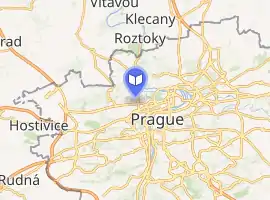Czech National Library of Technology
The Czech National Library of Technology (Czech: Národní technická knihovna, abbreviated as NTK) is located at Technická 6 in Prague 6. The building also houses a branch of the Municipal Library of Prague. The former site of the National Library of Technology was the Clementinum in the Old Town of Prague, from which all books and materials were moved to the library's current location after completion of the current building in 2009. The building was designed by architects Roman Brychta, Adam Halíř, Ondřej Hofmeister and Petr Lešek of Projektil Architekti after winning first prize in an architectural competition held in 2000.[2]
 | |
| Country | Czech Republic |
|---|---|
| Type | Research library |
| Scope | Engineering, architecture, chemistry, computer science, mathematics, physics |
| Established | 1718 |
| Location | Technická 6 160 80 Prague 6 – Dejvice, Czech Republic |
| Coordinates | 50.1039389°N 14.3906217°E |
| Collection | |
| Items collected | Books, journals, electronic media |
| Size | 1.18 million media units [1] |
| Legal deposit | No |
| Access and use | |
| Population served | Professors, students, researchers, private sector clients, general public |
| Members | 25.5 thousand [1] |
| Other information | |
| Budget | Kč321.3 million [1] |
| Director | Martin Svoboda |
| Staff | 143 FTE [1] |
| Website | http://www.techlib.cz/en/ |
| Map | |

| |
Construction of the current building began in 2006 and was completed in January 2009. The library opened to the public on 9 September 2009 and now boasts the most extensive collection of Czech and international documents in the field of technology and applied natural and social sciences related to technology in the Czech Republic.[3]
The user-friendly design philosophy for the building has been described as a "high-tech living room for students" by the institution's Director Martin Svoboda.[4]
History
Today's National Library of Technology in Prague originated in 1718 as a collection of books belonging to the first Engineering Professor of the Czech Estates, Christian Willenberg (1655-1731).
Over the next two centuries, the library grew as part of the Estates School of Engineering and other predecessors to the present-day Czech Technical University in Prague between 1786 and the outbreak of World War II in various locations. The library moved to the Clementinum as the Technical Universities Library (TUL) in 1935.
In 1960, the library was renamed as the State Library of Technology (STK). Over time, the library began to outgrow space available at the Clementinum. Two remote storage facilities were procured between 1974 and 1981 in Prague 4-Písnice and in Lhota near Dolní Břežany (each with capacity for 200,000 volumes), and in the late 1990s, the Czech Ministry of Education approved construction of the current building in Prague 6.[5]
Gallery
 National Library of Technology in Prague (NTK) - a global view.
National Library of Technology in Prague (NTK) - a global view. The glass-clad façade of the National Library of Technology.
The glass-clad façade of the National Library of Technology. Glass cladding as viewed from inside the building.
Glass cladding as viewed from inside the building. The card-operated information kiosks scattered throughout the building enable printing and catalogue searching.
The card-operated information kiosks scattered throughout the building enable printing and catalogue searching. The atrium is naturally lit through the skylight.
The atrium is naturally lit through the skylight. Thematic directory stenciled on the bare concrete column. Almost all surfaces throughout the building are exposed concrete.
Thematic directory stenciled on the bare concrete column. Almost all surfaces throughout the building are exposed concrete. Graphic design follows the "technical schoolbook" concept.
Graphic design follows the "technical schoolbook" concept. Bold-coloured flooring and movable furniture is designed to give an openness and friendliness to the space.
Bold-coloured flooring and movable furniture is designed to give an openness and friendliness to the space. National Library of Technology in Prague (NTK) - year 2012.
National Library of Technology in Prague (NTK) - year 2012. National Library of Technology in Prague (NTK) - year 2012.
National Library of Technology in Prague (NTK) - year 2012.%252C_2019.jpg.webp) The library in 2019
The library in 2019
External links
References
- Czech National Library of Technology - Annual report online retrieved 16-March-2015
- http://www.archdaily.com/29600/national-tecnical-library-in-prague-projektil-architekti/
- "Archived copy". Archived from the original on 2010-06-23. Retrieved 2011-09-28.CS1 maint: archived copy as title (link)
- http://www.radio.cz/en/section/curraffrs/new-national-technical-library-opens-in-prague
- http://www.techlib.cz/en/2749-about-ntk#tab_history